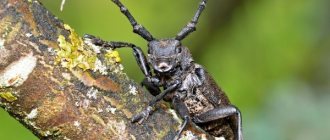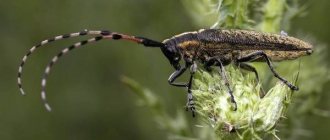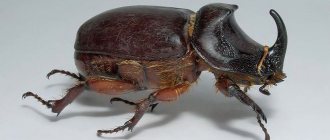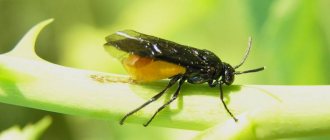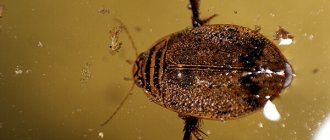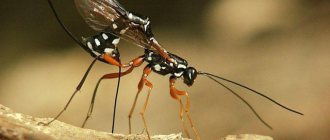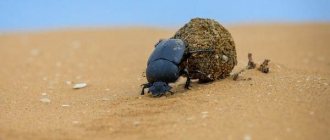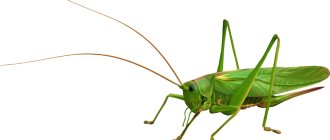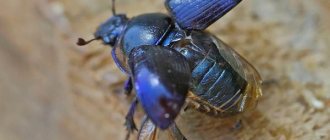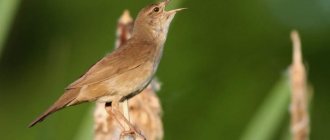- Wild animals
- >>
- Insects
The woodcutter beetle is a prominent representative of the Coleoptera order, famous for its huge mustache. Due to its external features, it is often also called barbel. This insect mainly lives in tropical countries, but is represented on almost all continents. It has more than twenty-five thousand varieties. And this is not the final figure. Every year, scientists discover more and more new species of longhorned beetles.
Origin of the species and description
Photo: Lumberjack Beetle
Lumberjacks are a very large family of beetles. They belong to the order Coleoptera and occupy fifth place in the number of species. As already noted, today scientists count more than twenty-five thousand varieties. The beetles got their name “woodcutter” due to their special “love” for wood. They not only eat wood, but also build their homes in it.
Interesting fact: The Titan Lumberjack is recognized as the largest beetle in the world. The length of its body can reach twenty-two centimeters. However, such a huge insect cannot be found in museums. The individuals presented for public viewing are no more than seventeen centimeters long.
Due to the fact that the wood is consumed by these beetles as food, they are considered pests. These insects cause enormous damage to human property, various buildings, and the environment. This multifaceted creature is distributed almost throughout the globe. The only exceptions are very cold areas of planet Earth. The largest populations are found in tropical regions.
A unique feature of these animals is their mustache. They are segmented, most often exceeding the length of the body itself by several times. Also a characteristic feature are the wings. However, not all members of the family can use them. Only a few species are endowed with the ability to fly. Woodcutter beetles, which are large in size, often look very clumsy when flying.
What does a beetle look like?
In the photo of the titanium beetle you can see a long and slender body. The body of the insect is expanded, slightly flattened in the direction from the back to the peritoneum. When viewed from the side, the Lumberjack Titan looks like a lens. The body has a brown-brown color. But it can be black, blue-gray, white, green. On the upper part, some notice various patterns with stripes and spots. The head is positioned straight. On the first segment of the chest, there are 3 sharp spines on each side. The beetle has antennae in front of its eyes, which can be half the length of its body. The insect has 3 pairs of legs with sharp claws. The beetle has wings, which can sometimes come in handy. For example, some are born with the ability to fly.
Appearance and features
Photo: Insect woodcutter beetle
Most representatives of lumberjacks have average body dimensions. Only a small number belong to the group of giants - these are titanium and bigtooth. Their average length is 167 millimeters. Such animals live mainly in Young America. Beetles from Fiji are smaller in size. Their length can reach fifteen centimeters. The carpenter's barbel (up to 6 centimeters) is a giant among European species, the relict barbel (up to 11 centimeters) is a large representative of the order living in Russia.
Video: Lumberjack Beetle
A significant part of the insect's length is occupied by the whiskers. Sometimes they exceed the body length by four to five times. The body of the woodcutter beetle is slender, slightly elongated. There may be various spots and stripes on it.
The colors come in a variety of colors:
- gray-blue;
- black-brown;
- greenish;
- white;
- mother-of-pearl;
- pale yellow.
Interesting fact: Among the adult woodcutter beetles there are atypical species. One of them is the Parandra barbel. It has small dimensions and is considered the most primitive. The body of such an insect is flat and very wide. For this reason, it is often confused with stag.
Lumberjacks can make various sounds. The sound is produced by the friction of the rib on the surface of the mesothorax. The sound is creaking, not very pleasant. Beetles use it as protection. The sound is made in the event of an enemy attack; it is of a frightening nature.
Notes
- Kryzhanovsky O. L., Mamaev B. M. Order Coleoptera, or Beetles (Coleoptera) // Animal Life. Volume 3. Arthropods: trilobites, chelicerates, trachea-breathers. Onychophora / ed. M. S. Gilyarova, F. N. Pravdina, ch. ed. V. E. Sokolov. — 2nd ed. - M.: Education, 1984. - P. 282. - 463 p.
- Catalog of Life: [https://www.catalogueoflife.org/col/browse/tree/id/7ca3293359de6c96012c60d54f706f0f Genus Titanus
] Retrieved July 06, 2016. - ↑ Yukio Yaznda & Shuji Okejima “Kafer der Welt”, 1990, 126 pages, 700 col illus
- Vanessa Hequet. Longicornes de Guyane. Cayenne, 1996
- Charles Leonard Hogue: Latin American Insects and Entomology. University of California Press, 1993 ISBN 0-520-07849-7 s. 280
- Mares J., Lapacek V. Nejkrasnejsi brouci tropu. Praha, 1980. 108 p.
- [https://ebay.com/ eBay - New & used electronics, cars, apparel, collectibles, sporting goods & more at low prices]
- [https://www.entomoservice.com/catalog/advanced_search_result.php?keywords=Titanus+giganteus+&x=10&y=10 entomoservice.com]
Where does the woodcutter beetle live?
Photo: Relic woodcutter beetle
The longhorned beetle can thrive almost anywhere there is wood. The only exception is regions with too low temperatures. The favorite tree species of such insects are conifers. However, they also live in other trees, shrubs and even herbaceous plants. Sometimes insects choose country houses and dachas to live. They can feed on wooden furniture and building elements, which causes great harm.
The largest representative of the family, the titanium beetle lives in Colombia, Peru, Ecuador, and Venezuela. They settle in the Amazon River basin. Residents of these countries sometimes independently attract such insects to their homes, then sell them for huge sums. The demand for titan beetles is very high among collectors.
In European countries, Iran, Turkey, Western Asia, the Caucasus and the Urals, woodcutter beetles live in large populations. They also live in Moscow. Animals choose deciduous, mixed forests to live. They settle in dead trees. In general, about five hundred species of longhorned beetles live in Russia. Other species of the woodcutter beetle are present on almost all continents. They live in Poland, Belarus, Ukraine, and Moldova.
What does the woodcutter beetle eat?
Photo: Big woodcutter beetle
The main diet of woodcutter beetles consists of leaves, pollen, and needles. Some members of the genus prefer to eat only juice. The bark on young branches becomes food less often. Middle-aged individuals feed on it. The bark of young twigs is a “diet” food. It helps the germ cells mature.
The black house woodcutter brings great harm to humanity. It inhabits building materials, furniture, and wooden elements of residential and commercial buildings. Such beetles not only make cracks for themselves to live there, but also lay larvae in them. There have been cases in the world when barbel larvae almost completely destroyed wooden houses in entire neighborhoods.
The larvae's diet consists mainly of dead wood. This is due to the fact that a living tree has too little protein. Protein is necessary for larvae to grow and develop. In rotting trees, where fungi have developed, there is much more of this necessary protein.
Interesting fact: There are adult woodcutter beetles in the world that do not eat food at all.
An example of insects that can survive without food is the titan beetle. It lives off the nutrients that it was able to accumulate while still in the larval stage. Beetles tolerate a period of starvation absolutely normally. And the entire adult period does not last long - only a couple of weeks.
Nutrition
It is already clear that the nutrition of such insects is directly related to trees, most often pine needles. The woodcutter beetle is also capable of feeding on plant pollen and leaves. However, much depends on the habitat of such insects and, as can already be concluded from the above, on the variety.
Often the very name of representatives of a certain species speaks volumes about the preferences of these creatures. For example, the bark beetle loves to feast on bark. But being a gourmet, he chooses fresher delicacies, devouring young branches with insatiability.
Scientists believe that the substances that beetles receive on such a diet have a beneficial effect on the formation of germ cells that mature in the body of such insects. Well, the house woodcutter likes to settle in people’s homes and cause them a lot of trouble, feeding on house wood.
There are also more harmless varieties of such beetles; they feed on tree sap and flower nectar. And some species of these insects in adulthood completely refuse food.
These include the titanium barbel. For mature individuals, the reserves that they received in the form of nutrients at the larval stage are usually sufficient. They themselves, having reached maturity, live no more than a few weeks and the purpose of their existence is solely to fulfill their reproductive role.
Features of character and lifestyle
Photo: Lumberjack Beetle Red Book
Lifestyle and rhythm of life depend on a number of factors:
- location;
- climate, weather conditions in the region;
- food quality;
- gender
Adult beetles living in the southern regions begin to be active in mid-spring. The woodcutter beetle flies in Central Asian territory only in early autumn. Rare members of the family lead a diurnal lifestyle, feeding on flowers. Other species prefer to fly, breed and feed in the dark.
Most adult longhorned beetles spend their time hidden during the day. There they rest and eat. Such insects fly extremely rarely. This is due to the large dimensions of the body. It is difficult for such bugs to take off and land softly. Only some of the flying species can carry out long flights. At the same time, in some species females fly more, in others - males.
The woodcutter beetle is an insect with a terrifying appearance. However, it does virtually no physical damage to humans. The barbel does not bite unnecessarily and has a calm character. History knows only a tiny number of such incidents. And the bite itself is not dangerous to humans. It heals quickly.
Behavior
The activity of these insects is determined by weather conditions. As a rule, in southern countries, flight begins in the spring. The larger and larger a titan woodcutter, the more difficult it is for him to move in the air. Therefore, flying is definitely not an easy task for them. Throughout the day, titan lumberjacks hide in hollow trees or rotten logs.
Activity occurs at night. The difficulty in finding imago titan lumberjacks lies in the extremely short life of these representatives. An adult lives no more than 5 weeks. Spikes and mandibles can only be used for self-defense. The beetle itself does not pose a great danger to humans.
Social structure and reproduction
Photo: Lumberjack Beetle
Female lumberjacks lay eggs in the spring. For breeding, they very carefully select a secluded place. This is due to the fact that the place will serve not only as a “roof” over your head, but also as a source of food for the larvae. Most often, eggs are laid in large cracks in wood. Females prefer coniferous species: pine, cedar, spruce. Insects determine the type of tree by its subtle aroma.
Female longhorned beetles can lay varying numbers of eggs. Sometimes their numbers reach several hundred at a time. Two weeks after laying, larvae begin to appear. They are white in color and have an awkward appearance. Longhorn beetle larvae resemble worms and are highly voracious.
Interesting fact: The woodcutter beetle often interbreeds with other species. This leads to the formation of a large number of hybrids.
Woodcutter beetle larvae have strong, powerful jaws and high survival rates. They not only live in wood, but also actively make passages there to search for a new source of food. The appetite of the larvae is monstrous. In large concentrations, they are capable of completely destroying a wooden structure in a short period of time.
Woodcutter beetle larvae live for more than one year. There is a long period before reaching adulthood. For some it is one year, and for some species it is about two years. Adults live a tiny amount of time - no more than twenty-five days.
What are some interesting facts?
There are various interesting facts about the insect:
- female titanium lumberjacks are larger than males;
- the name comes from the powerful jaws of the insect, with which the beetle is able to bite a branch with a diameter of 1 cm;
- males have longer antennae than females;
- Longhorn beetle larvae are considered a delicacy in the south, so it is possible that someone saw a titan woodcutter, but simply did not talk about it and ate it for lunch.
Males and females can be distinguished by the length of their whiskers
Natural enemies of woodcutter beetles
Photo: Lumberjack beetle
The most dangerous natural enemies of adult woodcutter beetles are woodpeckers. They are the ones who most often attack insects. They are also preyed upon by other bird species. Longhorn beetles often become victims of predatory insects. They are less often attacked by parasitic microorganisms. The latter kill animals slowly but surely.
The larvae live in secluded places, so they are less likely to become victims of natural enemies. They are preyed upon by wasps, parasitic microorganisms and other types of beetles.
Adult woodcutters do not suffer as much from predators and birds as from the hands of humans. Rare species of longhorned beetles, especially large individuals, are in particular danger. In most countries, they are hunted by collectors and exotic lovers. They catch them for their collections or for sale. In America, for example, you can get about a thousand dollars for a woodcutter beetle.
Population and species status
Photo: Woodcutter beetle from the Red Book
The woodcutter beetle has about twenty-five thousand species. For this reason, the family cannot be called endangered. The population of such insects in the main area of residence is quite large and is not threatened. However, many species of longhorned beetles are rapidly declining. Some species are even listed in the Red Data Books of European countries.
The following factors influence the decline in the population of certain species of lumberjacks:
- massive deforestation of coniferous forests. Coniferous wood has become increasingly used during construction and furniture making. Uncontrolled logging leads to the destruction of the “homes” of woodcutters;
- catching beetles by collectors. This is due to the high cost of individuals on the market;
- destruction of insects by humans. The woodcutter beetle, especially its larvae, is a pest. Those individuals that settle in houses and dachas are periodically destroyed using special compounds.
